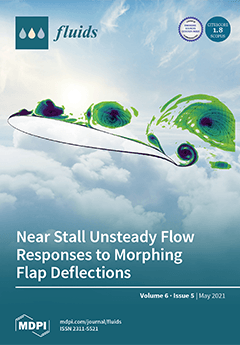This paper addresses the challenges of pressure-based sensing using axisymmetric probes whose axes are at small angles to the mean flow. Mean pressure measurements around three yawed circular cylinders with aspect ratios of 28, 64, and 100 were made to determine the effect
[...] Read more.
This paper addresses the challenges of pressure-based sensing using axisymmetric probes whose axes are at small angles to the mean flow. Mean pressure measurements around three yawed circular cylinders with aspect ratios of 28, 64, and 100 were made to determine the effect of changes in the yaw angle,
γ, and freestream velocity on the average pressure coefficient,
, and drag coefficient,
. The existence of four distinct types of circumferential pressure distributions—subcritical, transitional, supercritical, and asymmetric—were confirmed, along with the appropriateness of scaling
and
on a streamwise Reynolds number,
, based on the freestream velocity and the fluid path length along the cylinder in the streamwise direction. It was found that there was a distinct difference in the values of
and
at identical
values for cylinders yawed between 5° and 30°, and for cylinders at greater than a 30° yaw. For
γ < 5°, there did not appear to be any large-scale vortices in the near wake, and
and
pN appeared to become independent of
. Over the range of 5° ≤
γ ≤ 30°, there was a complex interplay of freestream speed, yaw angle, and aspect ratio that affected the formation and shedding of Kármán-like vortices.
Full article





